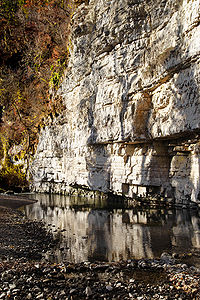- Dactylosaurus
-
Dactylosaurus
Temporal range: Middle Triassic (Anisian?)Scientific classification Kingdom: Animalia Phylum: Chordata Class: Sauropsida Superorder: Sauropterygia Order: Nothosauroidea Suborder: Pachypleurosauria Family: Pachypleurosauridae Genus: Dactylosaurus
Gürich, 1884Species - Dactylosaurus gracilis Gürich, 1884 Type
Synonyms - Dactylosaurus schroederi Nopcsa, 1928 (junior synonym for D. gracilis)
Dactylosaurus is a genus of nothosaur in the family Pachypleurosauridae. Along with Anarosaurus, Dactylosaurus was one of the earliest known pachypleurosaurs to come from Europe.[1]
Contents
Etymology
Dactylosaurus comes from the Greek daktulos (δακτυλος), "finger" and sauros (σαυρος), meaning "lizard" or "reptile."
Description
The nasal bones of Dactylosaurus meet and are broadly structured.[2] The upper temporal fenestra is large and kidney-shaped.[2] There are 17 cervical vertebrae[2] and the cervical ribs have anterior processes.[2] The maxillae of Dactylosaurus extended broadly up the side of the snout.[1]
D. gracilis
The holotype specimen (MGUWR WR 3871s) of D. gracilis was only a partial skeleton, consisting of the anterior end alone.[1] Because it differed slightly from the fossils of D. gracilis, it was first thought to belong to the species D. schroederi,[1] which is now considered a junior synonym for juvenile D. gracilis.[2] Once this was established, the juvenile fossil, which was found before the adult fossils, became the holotype. The one limb that was found (a left forelimb), was noted to have a slimmer radius and ulna than Neusticosaurus,[1] a similar nothosaur from Europe.[1] D. gracilis is the smallest known species in its family,[1] which includes the much more recognized Keichousaurus, a nothosaur often remembered for its small size.[3] The original holotype of D. gracilis is considered a juvenile,[2] however the size of a nothosaur when its bones harden is used to show size, making the estimate as smallest member of its family still valid.[1]
Distribution
 Muschelkalk, a German form of shelly limestone, occasionally produces Dactylosaurus fossils in its lowest layers.
Muschelkalk, a German form of shelly limestone, occasionally produces Dactylosaurus fossils in its lowest layers.
Dactylosaurus lived in the Middle Triassic period during the Anisian faunal stage, of central Europe.[4] In terms of geology, they are found in the lowest Muschelkalk layers, in and around the Gogolin Formation.[4]
References
- ^ a b c d e f g h Lepidosauromorpha: Pachypleurosauridae: Dactylosaurus & Anarosaurus Palaeos.com. Last accessed 2008-07-04.
- ^ a b c d e f Rieppel, O & L Kebang (1995), "Pachypleurosaurs (Reptilia, Sauropterygia) from the Lower Muschelkalk, and a review of the Pachypleurosauroidea." Fieldiana Geol. N.S. 32: 1-44.
- ^ "peripatus.gen.nz entry on Keichousaurus". http://www.peripatus.gen.nz/Taxa/Chordata/Keichousaurus.html. Retrieved 2008-06-12.
- ^ a b "plesiosauria.com entry on Dactylosaurus". http://www.plesiosauria.com/dactylosaurus.html. Retrieved 2008-06-13.
External links
- Pachypleurosauridae from Palaeos.com (technical)
- Dactylosaurus from the Plesiosaur Directory
Kingdom: Animalia · Phylum: Chordata · Class: Reptilia · Subclassis: Diapsida · Infraclassis: LepidosauromorphaMajor clades Basal sauropterygiansEosauropterygiaSanchiaosaurusEusauropterygiaNothosauroideaPistosauroideaPlacodontia Basal placodontsCyamodontoideaMacroplacus · Protenodontosaurus · PsephosaurusPlacochelyidaeNothosauroidea Anarosaurus · Dactylosaurus · Hanosaurus · Keichousaurus · Neusticosaurus · Pachypleurosaurus · SerpianosaurusSimosauridaeSimosaurusGermanosaurinaeGermanosaurusLariosaurinaeOther generaMetanothosaurusPistosauroidea Augustasaurus · Bobosaurus · Chinchenia · Corosaurus · Cymatosaurus · Kwangsisaurus · Pistosaurus · Yunguisaurus · PlesiosauriaRelated categories Sauropterygia · Placodonts · Plesiosaurs · Triassic reptiles · Jurassic reptiles · Cretaceous reptilesCategories:- Prehistoric reptiles of Europe
- Triassic plesiosaurs
Wikimedia Foundation. 2010.
